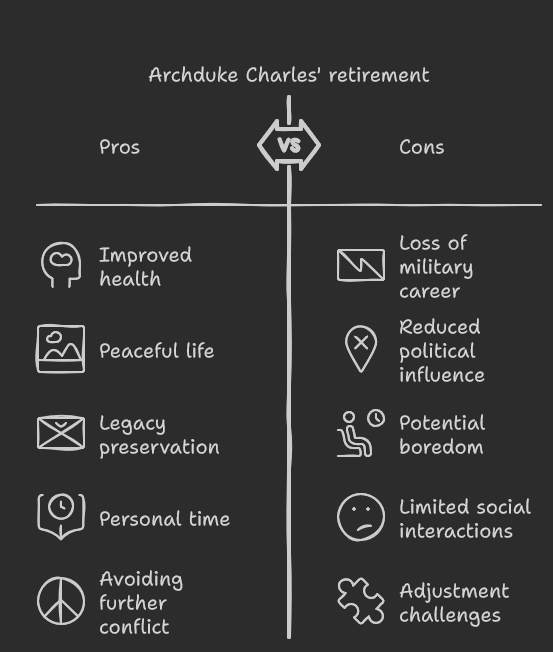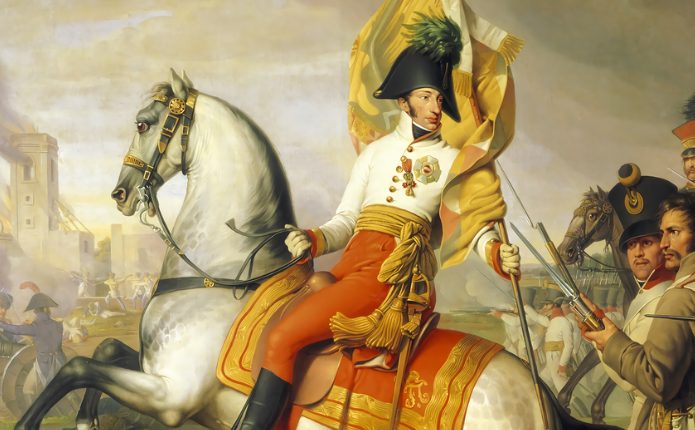Archduke Charles of Austria, Duke of Teschen (1771–1847), was a pivotal figure in European military history, particularly during the tumultuous years of the Napoleonic Wars. Known for his strategic brilliance, Charles played a crucial role in shaping the Austrian army, both as a general on the battlefield and as a reformer who modernized the military system. His leadership was instrumental in several significant victories, including the famous Battle of Aspern-Essling in 1809, where he handed Napoleon his first major defeat. This blog will explore his early life, military achievements, and lasting legacy, shedding light on how he shaped Austria’s military landscape during one of Europe’s most volatile periods.
I. Early Life and Background
Birth and Family:
Archduke Charles was born into the illustrious Habsburg dynasty on September 5, 1771. He was the third son of Emperor Leopold II and younger brother to Emperor Francis I. As a member of one of Europe’s most powerful royal families, Charles was destined for a prominent role in the empire, with close ties to the imperial family that would shape his future in both politics and military service.
Health and Early Challenges:
From a young age, Charles faced significant health challenges, including epilepsy, which made his early life particularly difficult. Despite these obstacles, he demonstrated remarkable resilience and determination, ultimately overcoming these health issues to build an impressive military career. His early struggles likely contributed to the discipline and strength of character that defined his leadership in later years.

II. Military Career
A. Early Victories (1790s)
During the French Revolutionary Wars, Archduke Charles established his early reputation as a brilliant strategist through decisive victories. In 1796, he achieved key successes against French forces at the battles of Amberg and Würzburg. At Amberg, Charles used his understanding of terrain and troop positioning to outmaneuver the French, resulting in a significant Austrian victory. Shortly after, his triumph at Würzburg further solidified his standing as one of Austria’s foremost military commanders. These victories marked Charles as a rising star in European warfare, giving Austria hope during a time of revolutionary upheaval across the continent【11†source】【13†source】.
B. The Battle of Aspern-Essling (1809)
Archduke Charles’ most notable military achievement came during the Napoleonic Wars at the Battle of Aspern-Essling in May 1809. This engagement was significant as it marked Napoleon’s first major defeat, a critical blow to the myth of French invincibility. Charles, commanding the Austrian forces, managed to halt Napoleon’s advance across the Danube River near Vienna, inflicting heavy casualties on the French army. The battle, fought over two days, was a tactical victory for Charles, and although the French were not decisively crushed, it demonstrated that Napoleon could be beaten in open battle. The Battle of Aspern-Essling remains a landmark event in European military history, as it demonstrated Austria’s ability to stand against Napoleon’s Grande Armée【13†source】【11†source】.
C. Setbacks and Defeats
Despite his victories, Archduke Charles faced notable defeats as well. One of his significant setbacks occurred during the Battle of Caldiero in 1805, where he was defeated by French General André Masséna. This loss occurred during Napoleon’s campaign in Italy and highlighted the ongoing challenges Austria faced in the face of France’s superior tactics and coordination. Despite this defeat, Charles’ leadership remained respected. His ability to learn from these experiences contributed to his resilience and effectiveness as a commander in future campaigns, particularly in his reforms of the Austrian military【12†source】【13†source】.
III. Reforms in the Austrian Army
Military Reforms Post-1805
Following Austria’s defeats, particularly the losses in 1805, Archduke Charles took on a more transformative role as a reformer of the Austrian military. He was determined to modernize the army to compete with Napoleon’s highly organized forces. Over the next few years, Charles implemented several critical reforms:
- Introduction of the corps system: This allowed for better flexibility and independent operations among divisions, mirroring the structure of the French army.
- Improvements in artillery: Enhancing the effectiveness of Austria’s artillery units was crucial in increasing firepower on the battlefield.
- Logistical overhauls: Charles understood the importance of efficient supply lines and mobility, and he worked to modernize the logistics of the Austrian army to keep up with Napoleon’s fast-paced campaigns【13†source】.
These reforms, particularly the corps system, proved essential in Austria’s later military efforts and helped Austria resist Napoleon’s advances more effectively. Charles’ work in modernizing the army left a lasting legacy that continued to influence military strategy long after the Napoleonic Wars【11†source】【13†source】.

IV. Retirement and Later Life
Retirement from Active Service
After the fall of Napoleon and the conclusion of the Napoleonic Wars, Archduke Charles retired from military life. His decision to step away from active service was influenced by his health issues, including his long-standing epilepsy, and his recognition that his role in the military had reached its natural conclusion after the war. Charles had played a vital part in Austria’s defense against Napoleon, and with peace restored, he chose to retire in the 1820s, distancing himself from further military or political involvement【11†source】.
Quiet Life Away from Politics
In his later years, Archduke Charles led a quiet life, avoiding major political roles and responsibilities. Unlike many of his contemporaries, he did not seek to use his military reputation to gain political power or influence. Instead, he focused on his family and personal interests. His final years were spent in relative obscurity compared to his earlier public life. Charles passed away on April 30, 1847, leaving behind a legacy as one of Austria’s most distinguished military figures【13†source】.
V. Legacy
Archduke Charles’ Impact on Austrian Military
Archduke Charles’ military reforms had a profound impact on the Austrian army, shaping its structure and effectiveness long after his death. His introduction of the corps system and modernization of the army’s artillery and logistics improved Austria’s ability to conduct large-scale military operations. These reforms ensured that the Austrian army could compete with the more advanced and dynamic forces of other European powers, including France. The strategic and organizational changes he introduced continued to influence Austrian military doctrine throughout the 19th century and into the early 20th century【13†source】【12†source】.
Recognition as One of Austria’s Greatest Generals
Today, Archduke Charles is remembered as one of Austria’s greatest generals, known for both his victories and his ability to recover from setbacks. His defeat of Napoleon at Aspern-Essling remains one of the most celebrated moments in Austrian military history. Charles is also recognized for his commitment to reform, which helped strengthen Austria’s military capability. His legacy is that of a thoughtful and innovative leader who balanced battlefield brilliance with long-term military reform, securing his place as a key figure in European military history【11†source】【13†source】.
Conclusion
Archduke Charles of Austria, Duke of Teschen, was a military leader whose contributions to Austrian and European military history are both vast and lasting. His early victories during the French Revolutionary Wars and his stunning defeat of Napoleon at Aspern-Essling showcased his strategic brilliance, earning him a place among the great military commanders of his time. However, Charles’ contributions extended beyond the battlefield. His comprehensive reforms of the Austrian army, which included modernizing its structure and improving logistics and artillery, were pivotal in shaping the military’s future effectiveness.
Despite facing defeats, Charles demonstrated resilience, learning from setbacks and continuing to lead and reform the army. His decision to retire quietly after the Napoleonic Wars reflected his humility, as he chose not to seek political power despite his achievements. Today, Archduke Charles is remembered as one of Austria’s greatest generals, whose leadership and reforms have left an enduring mark on military history.
References
- World History Encyclopedia
(https://www.worldhistory.org) - Warfare History Network
(https://warfarehistorynetwork.com) - Wikipedia
(https://en.wikipedia.org)
FAQ: What Happened to Archduke Charles?
1. Who was Archduke Charles of Austria?
Archduke Charles of Austria, Duke of Teschen (1771–1847), was a prominent military commander and reformer in the Austrian army. He is known for his victories during the French Revolutionary Wars and the Napoleonic Wars, particularly for defeating Napoleon at the Battle of Aspern-Essling in 1809. He also played a key role in modernizing the Austrian military.
2. What were Archduke Charles’ major military achievements?
Some of his major achievements include:
- His victories at the battles of Amberg and Würzburg in 1796 during the French Revolutionary Wars.
- His most significant victory at the Battle of Aspern-Essling in 1809, where he became the first general to defeat Napoleon in open battle.
3. How did Archduke Charles contribute to the modernization of the Austrian military?
After Austria’s defeats in the early 1800s, Archduke Charles implemented extensive reforms to improve the Austrian army. He introduced the corps system, improved artillery, and revamped the army’s logistics. These reforms helped strengthen Austria’s military capabilities, making it more competitive against France’s Grande Armée.
4. Did Archduke Charles face any significant defeats?
Yes, despite his reputation for military brilliance, Archduke Charles suffered some notable defeats. One such defeat occurred at the Battle of Caldiero in 1805, where he was bested by French General André Masséna. However, he was able to recover from these setbacks and continue leading effectively.
5. Why did Archduke Charles retire from the military?
After the Napoleonic Wars, Charles retired from active military service. He had suffered from health issues, including epilepsy, throughout his life, and chose to spend his later years away from politics and military engagements. He passed away in 1847.
6. How is Archduke Charles remembered today?
Archduke Charles is remembered as one of Austria’s greatest generals and a key figure in European military history. His reforms left a lasting impact on the Austrian army, and his defeat of Napoleon remains one of his most celebrated achievements. He is also recognized for his balanced approach to both battlefield strategy and military modernization.




